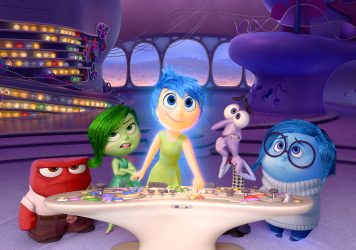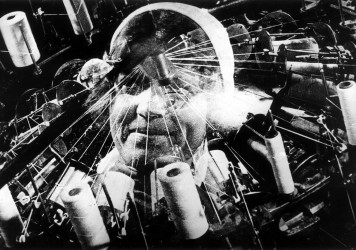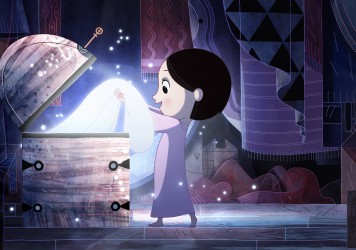The first feature film from Austin-based animation powerhouse, Don Hertzfeldt, is a rapturous joy to behold.
First there was darkness. Then a spark of remembrance. His synapses begin to fire out of control, so rapidly in fact that patches of the flat world peel away, revealing glimmers of subjective memory and history that exist in a perpetual vacuum of intense feeling. Whether or not these images are trustworthy remains a moot point; their very creation is a sign of tenacity and a will to live.
Such bright cinematic flickers allow every moment, no matter how mundane or false, no matter how monstrous or devastating, a sense of wondrous momentum that will never stop overlapping. To stop would be the equivalent of fading to black forever, and he has so much more to see.
So begins the formalist earthquake that is Don Hertzfeldt’s animation It’s Such A Beautiful Day, an immersive masterpiece of multiframed compositions, blotches of vibrant colour and elliptical editing that calls to mind the greats of Soviet montage. Previously released as three separate shorts (Everything Will Be OK, I Am So Proud Of You and It’s Such A Beautiful Day), this debut feature works wonders as a cohesive longform essay. Taken as a whole, it’s an ambitious and provocative blessing that manages to be about everything and anything and always without sounding pretentious.
Upon first viewing, it’s hard not to see it as The Tree Of Life of animation. Malick’s insanely lyrical sense of cinematic and musical progression is an undeniable influence on Hertzfeldt. Yet other auteurist threads become more pronounced on repeat viewings: Ozu’s obsession with loneliness and deterioration; Carpenter’s desire to reveal the monster hiding inside us all; and Kubrick’s pointed transitions from the familiar toward the epic unknown.
Told through the stricken eyes of Bill, a sickly yet endlessly inquisitive man perpetually tormented by the lovely contradictions of everyday life, Hertzfeldt’s film utilises a stream-of-consciousness style that engages ideas large and small, emotions vast and personal with effortless ease. Voiceover narration and classical music cues are essential to telling Bill’s multi-faceted story, which constantly calls into question the inconsistencies of his past, the hypocrisies of his present and the terrifying uncertainty of his not so distant future.
By exploring the opaque corners of Bill’s fractured tale in this very specific way, Hertzfeldt leans heavily on repetition to connect bits of irony and fate that sometimes take place hundreds of years apart. Take for instance the surrealist middle section of the film, where Bill’s past memories of family trauma produce a veritable wellspring of tall tales, disjointed visions and unexplainable happenstance.
One of the most devastating flashbacks involves Bill’s cousin Randall, a disabled boy with hooks for hands and flimsy legs. One sunny day, Randall sees a gull in the sky and joyously chases the bird into the ocean, never returning again. There’s so much feeling in the tenor of Hertzfeldt’s voice, as if the director was confessing something personal by way of his character’s perspective. Here, the sublime and heartfelt sit side-by-side.
The same relationship can be found when the film fully embraces routine as metaphor immediately after Bill is released from the hospital pending a near-death experience. During his daily walks around town, time and space seem to fold on top of each other into one infinite continuum, becoming a cinematic space for resilience. Instead of the usually dynamic split screens that dominate most of It’s Such A Beautiful Day, the image of Bill casually strolling down the street day after day, making the same observations, obviously suffering from some kind of mental breakdown, fills the frame entirely. Familiar life has become not so familiar, a mosaic of vaguely remembered thoughts projected over and over again.
Later, during the final segment, Bill transcends his illness and becomes a worldly and immortal being. Hertzfeldt’s scope tips from melancholic to grandiose. Bill’s endless quest to learn all languages and to experience all things can be seen as a prolonged moment of transcendence for a character once defined by self-doubt and now at peace with his own expanding potential. Clearly the process of living itself, with all of its strangeness and heartache and epiphanies, is what allows us to realise that death and fear are very different ideologies. Only one of them can truly destroy us.
That Hertzfeldt manages to do all this and more in just 61 minutes is not only a testament to the film’s breakneck pace and dynamic juxtapositions, but also its lasting and complex view of the human spirit. Over the course of the film, Bill learns to embrace the possibility of his own mortality without fear, and in turn, “he lives and he lives until all the lights go out.” The bitter end may not be so bitter after all.
Published 3 May 2013
Master animator Don Hertzfeldt’s first feature film!
A formalistic earthquake of sound and fury.
One of the great films about memory, perspective and past history.

Pixar are firing on all pistons with this wonderful, colour-coded exploration of a child’s inner psyche.

The winner of a recent poll to discover the greatest ever documentary is re-released.

Do Ghibli and Pixar have a new rival in Irish director Tomm Moore? This stunning film would suggest they do.